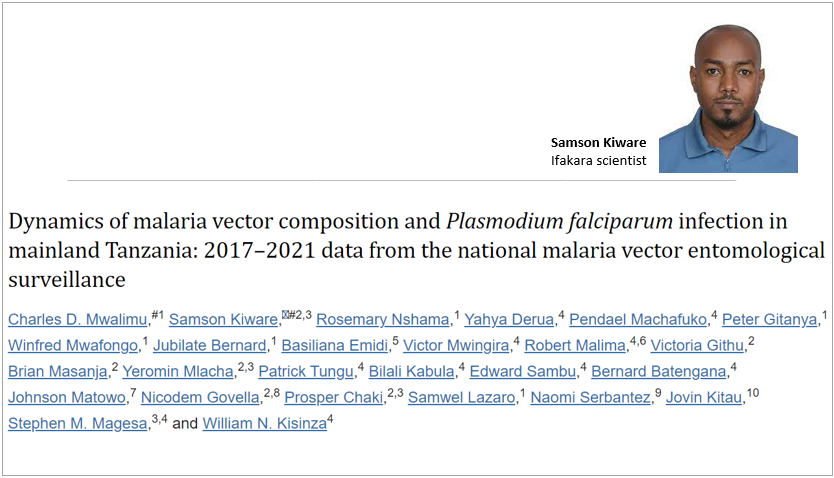
SURVEILLANCE: Findings provide new insights into better malaria control

After studying mosquitoes that spread malaria in Tanzania's Mainland using data from a five years surveillance, scientists have outlined the changing patterns of transmission, offering valuable insights into refining the disease’s future intervention strategies.
The findings, published on the Malaria Journal, were obtained from a malaria vector entomological surveillance carried out from 2017 to 2021 focusing on understanding the behavior and types of mosquitoes carrying the malaria parasite, including assessing their composition, abundance, feeding habits, and malaria infection rates.
Tanzania’s NMCP lead the study
Spearheaded by the Tanzania National Malaria Control Programme (NMCP), the study involved collaboration among scientists from Ifakara Health Institute scientists, Pan African Mosquito Control Association (PAMCA), National Institute for Medical Research (NIMR), University of Dar es Salaam-Mbeya College of Health and Allied Sciences, Kilimanjaro Christian Medical University College (KCMUC), Population Services International (PSI), U.S. President’s Malaria Initiative (PMI), and World Health Organization's Country Office in Tanzania.
Study approach
The scientists applied the Malaria Vector Entomological Surveillance (MVES) program set up by the NMCP in 2016, to monitor mosquitoes. The surveillance regularly checks vector species composition, their abundance and seasonality, feeding and resting behaviour to guide the deployment of appropriate vector control interventions and assess their performance over time.
Explaining the MVES program, the scientists wrote, “The MVES focuses on establishing the dynamics of malaria vector composition, sporozoite rates, and entomological inoculation rates across different malaria transmission strata.”
“The establishment of functional MVES was in line with the Global Technical Strategy for Malaria (2016–2030), which emphasizes strengthened and sustained epidemiological and entomological surveillance systems through substantial long-term financial and political commitment,” they added.
In Tanzania, the implementation of MVES was a collaborative effort between NMCP and the President’s Office of Regional Administration and Local Government (PO-RALG), the National Institute for Medical Research (NIMR) and financially supported by the Global Fund (GF).
23 regions involved
During the study, the MVES program closely monitored mosquito dynamics across different transmission strata in 32 district councils across 23 regions in Tanzania where mosquitoes were collected by trained community members supervised by NMCP and research institutions. Three consecutive night catches were performed monthly in randomly selected households using various trapping methods.
Collected mosquitoes were sorted and identified in the field and thereafter sent to the laboratory for further testing using advanced techniques to identify the mosquito species and for malaria parasite detection.
What the study found
A total of 63,226 mosquitoes were collected and studied over the five-year period. The most dominant mosquito species was Anopheles arabiensis, identified as the main carrier of the malaria parasite followed by Anopheles funestus s.s., also playing a significant role.
"This work provides an update on malaria vectors in Tanzania from 2017 to 2021 based on different transmission strata. An. arabiensis is still the most abundant vector species found across most district councils, but An. funestus s.s. is equally contributing to malaria transmission, especially in the high transmission stratum.”
What action can be taken?
Following the study findings, the scientists underscore the need to improve protection both indoors and outdoors to effectively combat malaria, targeting the particular mosquitoes known as carriers of the disease.
“The NMCP and partners must maintain and strengthen indoor control interventions targeting An. funestus s.s. and An. gambiae s.s., but equally important to consider targeting outdoor transmission that is mediated by An. arabiensis.”
To address outdoor transmission by An. arabiensis, they recommended strengthening integrated vector management, including larval source management. This approach includes managing their breeding areas which is crucial in places where the rate of mosquito bites that can cause malaria is too high, aiming to significantly decrease the number of malaria cases.
Ifakara scientists in the study
Scientists from Ifakara led by Samson Kiware, co-lead author contributed to the study. They include Victoria Githu, Brian Masanja, Yeromin Mlacha, Nicodem Govella and Prosper Chaki
Read the full publication here.
